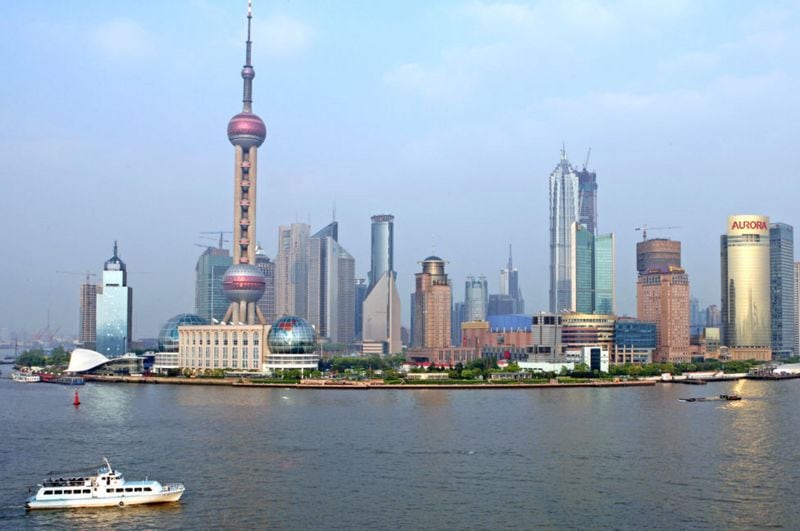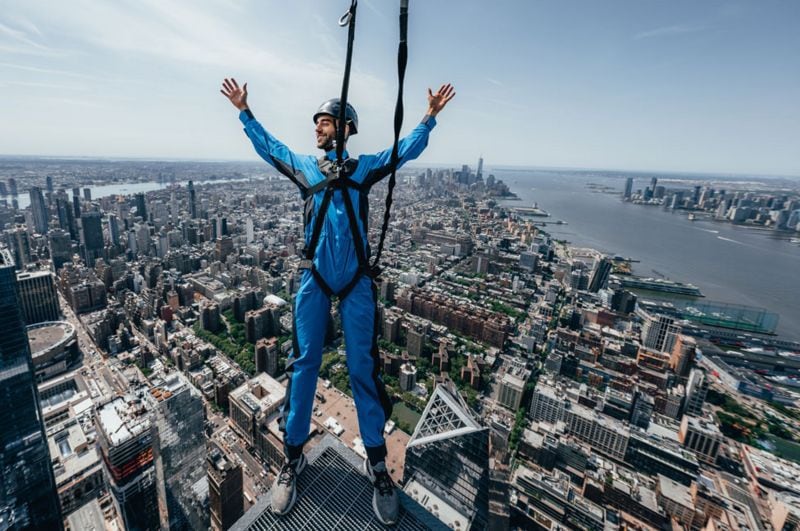The authorities in China they have limited the construction of very tall buildings, calling them “vain projects”. The move came at a time when offices around the world are full of empty desks and some employees are afraid of sharing hermetically sealed spaces.
The author Judith Dupre he wonders, what is the future of skyscrapers?
- The powerful influence of the Canaries on Caribbean Spanish (and what makes Canaries accents sound like Cubans or Venezuelans)
- Travel to the US: What vaccinations and other requirements will be required as of November 8?
- COVID-19 | Why Europe is (again) the epicenter of the pandemic, according to WHO
90 years ago, after the world overcame a global pandemic and was on the brink of a devastating economic meltdown, the golden age of the skyscraper began.
The most iconic – the Chrysler Buildings and the Empire State Building in New York – were the tallest structures ever built and captured the public’s imagination.
The pinnacle of the Chrysler, secretly assembled inside the building in a cunning stroke, earned the tower the prestigious title of “tallest in the world” in 1930. A year later, the Empire State snatched the title from it, but the huge building had problems renting spaces, to the point that it was nicknamed “Empty State” (which means “empty state”).
Things have changed when the classic film “King Kong” was released in 1933, about the gigantic gorilla who falls in love with a human and climbs the skyscraper with her in his hands. The film promoted the leasing of offices and the floors of the skyscraper were filled.
The second golden age of skyscrapers has occurred in the last 20 years, although the construction of these buildings has slowed or paused everywhere. In 2020 there was a 20% drop in the number of tall buildings that were completed, compared to the previous year, according to the Council on Tall Buildings and Urban Habitat (CTBUH).
What will happen in a post covid world? Will skyscrapers continue to be built?
After the September 11, 2001 attacks in New York, the tall towers were predicted to die, an extremely premature prediction. More skyscrapers have been built in the last 20 years than in the entire last century, and they are safer, stronger and more environmentally friendly than ever, thanks to the rigorous building standards that were adopted globally after the attacks on the Twin Towers.
The fortune of a nation can be linked to the title of the “tallest building in the world.” This is how the Petronas Towers put Kuala Lumpur on the map and the Burj Khalifa, the tallest structure in the world, turned Dubai into a global destination.
These towers also stimulate new construction. “Around the Burj Khalifa, a 121-hectare plot with lots of buildings was created and it worked,” says Adrian Smith of the architectural firm Adrian Smith + Gordon Gill Architecture, whose high-end projects include the Burj Khalifa and Jeddah Tower in Arabia. Arabia, which will become the tallest building in the world when completed.
Still, architects are questioning the classic formula behind skyscrapers: high population density + high land prices = tall buildings.
There has to be a good reason to build a 500 meter building, says Kamran Moazami, CEO of British construction company WSP, whose projects include the tallest building in London (The Shard), the tallest in the US (One World Trade Center) and the tallest in Asia (the Shanghai Tower).
“You have to ask yourself what is the best and most economical way to build. Extreme height can create a travel destination, like in Dubai, but that is not needed in cities like Shanghai or Manhattan. Today an iconic tower is judged not only by its appearance but by its use of carbon. “
But whether it’s an icon or not, not everyone is a fan of skyscrapers, especially new ones with glass facades.

And it is that they produce “Aesthetic contamination”, according to architecture critic David Brussat. “Somehow, as the architecture grew in altitude, it got smaller. People get depressed having to walk to work through boring urban cliffs. ” The skyscrapers of yesteryear, he says, were designed at the public level to delight the passerby, and invited a “civic reciprocity that was important in everyday interactions.”
The coronavirus drastically changed everything that makes urban life desirable– Vibrant public places, mass transit connectivity, and easy access to restaurants, museums, and clubs. Yet cities are on the mend, some faster than others, and people building skyscrapers predict that they will be back too, though not like before.
“The pandemic demonstrated that neighborhoods with a diverse mix of residential and office buildings withstood the long lockdowns better,” says Scott Rechler, president and CEO of RXR, one of the largest real estate owners, managers and developers in the region. from New York.
“It drove structural changes in the office market, with more companies looking for newer buildings, what the industry refers to as a ‘quality trip’, and making older office buildings completely obsolete.” Older buildings are being converted for new uses, he adds, as residential towers, making business districts more diverse.
“By no means has the commercial real estate market died,” says Rechler. “The talent has returned to New York City. They want to live and work here. The demand for office spaces in the 21st century and with many services is higher than ever ”.
New York City’s aggressive public health action, which has achieved an overall vaccination rate of 87%, has helped respond to that demand, he says. And the spaces within office buildings are also changing according to the needs posed by the pandemic: more fresh air, sunlight and open spaces.
They are being designed more in terms of collaboration, rather than laying out rows of desks, Moazami explains. “Demand will not decrease, but the way an office is occupied will be different. You can no longer assume that employees work Monday through Friday from 9 to 5. You could need more space for fewer people ”.
In cities, the demand for outdoor spaces has also skyrocketed.
Skyscrapers are usually in big cities and its future depends on the return of employees to the offices.
But not everyone wants to return. Working at home in yoga pants has its advantages, although a return for some seems inevitable.

We are a social species. Studies conducted before the pandemic showed that emotional isolation – loneliness – can be as bad for your health as smoking. More than that, there is a magic that happens when humansCreatives especially work closely with each other. “Now we know that remote work is productive, but people have to come together to collaborate,” says Moazami. “You move, you absorb, you learn.”
There are other costs of working remotely, particularly in industries that are highly visual and spatial. “Computer communication can be challenging in terms of directing and controlling a product. Customers have a hard time understanding a building model when they see it on a screen, ”says Smith.
Historically, crises have sparked innovation. For tall buildings, the post-pandemic era could be different, if China, the leader in skyscraper construction, is a reference. To put its explosive growth of the past two decades into context, let’s consider this: in all the world there are 115 “super-tall” buildings of more than 300 meters. China has built 85 of them.
China is protecting itself, applying strategies to fill its empty skyscrapers, improve its economy and shore up its national identity, damaged by the covid.
In 2020, the Chinese government announced extensive height and design restrictions for the new skyscrapers. In addition, they banned copies of buildings and replicas of Western monuments such as the Eiffel Tower, the Kremlin and others found throughout China.
In July, restrictions were tightened even further, with a view to limiting height: new buildings were banned from being taller than 500 meters and the number of 250 meters was limited. More recently, China banned buildings taller than 150 meters in cities with fewer than three million inhabitants. This has had financial repercussions, particularly for Western architectural firms, which have built many of China’s super-tall towers.
“China has over-built in all spheres, with many projects that did not have to be built, but did so to keep the population working and increase productivity,” says Smith, whose firm has designed the top five skyscrapers. from China.
The government recognized that “it would be better to start building towers with economic sense that could be leased. In other words, they started to think like American builders. ” Skyscrapers cannot be built to grow an economy, but to satisfy an existing need.
In any case, 8 of the 10 tallest buildings currently being built are in China.
Skyscrapers express power, economic strength, and technical ability, attributes that are irresistible to nation builders.
RECOMMENDED VIDEO
IT MAY INTEREST YOU
- Homo bodoensis: the new species that a group of scientists considers “the direct ancestor of humans”
- Who was Guy Fawkes, the man the English burn every 5th of November?
- “I witnessed the plane crash in which my two sisters died when I was a child”
- How the “big capital” in Nicaragua went from being an ally to a rival of Ortega (and what could happen after the elections)
- The famine looming over North Korea, which may be the worst in decades
.

:quality(75)/cloudfront-us-east-1.images.arcpublishing.com/elcomercio/237EUPV275ANZNBD4W2U2O7AGU.jpg)

:quality(75)/cloudfront-us-east-1.images.arcpublishing.com/elcomercio/BJBQ4P3D4BG6VD5ZCD7JLLJP7I.jpg)
:quality(75)/cloudfront-us-east-1.images.arcpublishing.com/elcomercio/2UWLFA2YVRFM5DKNK7VAEXCHWI.jpg)

:quality(75)/cloudfront-us-east-1.images.arcpublishing.com/elcomercio/YK3D4IBND5CUVMVQYCVU6T6F5A.jpg)
